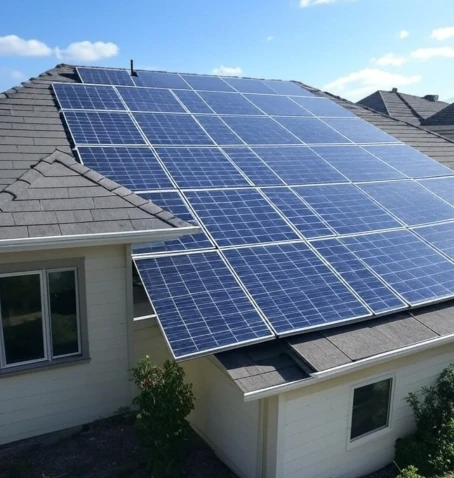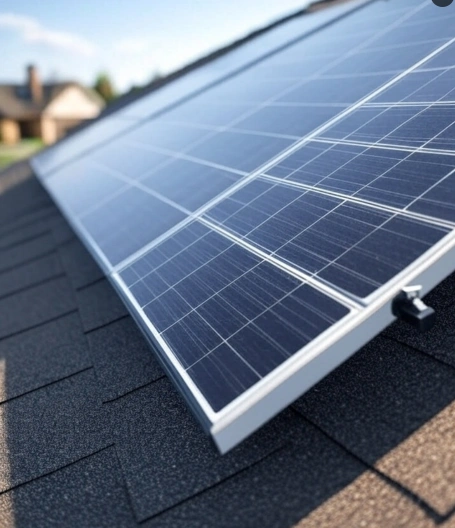
Determining the number of solar panels you need for your home in 2025 depends on your energy consumption, system efficiency, and local conditions. This article will guide you through the key factors and calculations to estimate the number of solar panels required for a typical U.S. household, using the most up-to-date data available.
Step 1: Assess Your Energy Consumption
The first step is to understand your annual electricity usage, typically measured in kilowatt-hours (kWh). According to the U.S. Energy Information Administration (EIA), the average U.S. household in 2025 consumes about 10,791 kWh per year, or roughly 900 kWh per month. You can find your specific usage on your electricity bill or through your utility provider’s online portal. For example, a household in a sunny state like California might use less due to milder climates, around 7,500 kWh annually, while a home in a colder state like Minnesota might use closer to 12,000 kWh.
If you aim to offset 100% of your electricity usage with solar, you’ll need to match your annual consumption with solar production. Let’s use the U.S. average of 10,791 kWh as a baseline for calculations.
Step 2: Calculate Your Solar System Size
To determine the size of the solar system needed (in kilowatts, kW), you need to account for the amount of sunlight your location receives, known as peak sun hours. Peak sun hours vary by region. According to the National Renewable Energy Laboratory (NREL), in 2025, the U.S. average is about 4 peak sun hours per day, though this ranges from 3 hours in Seattle to 5.5 hours in Phoenix.
The formula to calculate system size is:
System Size (kW) = Annual Energy Usage (kWh) ÷ (Peak Sun Hours × 365) × Efficiency Factor Assuming an efficiency factor of 0.85 (accounting for losses from shading, dirt, and inverter efficiency), for the average U.S. household:
Annual usage: 10,791 kWh
Peak sun hours: 4 hours/day
Days per year: 365
Efficiency factor: 0.85
System Size = 10,791 ÷ (4 × 365) × 0.85 = 8.7 kW
So, a system size of approximately 8.7 kW is needed to offset 100% of the average household’s electricity usage.
Step 3: Determine the Number of Solar Panels
Next, you need to know the wattage of the solar panels you plan to use. In 2025, the average residential solar panel has a capacity of 400 watts, though high-efficiency panels can reach 500 watts (SolarReviews data). Using a standard 400-watt panel:
Number of Panels = System Size (kW) × 1000 ÷ Panel Wattage
For an 8.7 kW system:
Number of Panels = 8,700 ÷ 400 = 21.75
Since you can’t install a fraction of a panel, you’ll need 22 panels to meet the 8.7 kW requirement. If you opt for 500-watt panels, the number drops to:
8,700 ÷ 500 = 17.4, or 18 panels.
Step 4: Account for Roof Space and Other Factors
Each 400-watt panel typically measures about 17.6 square feet (1.6m × 1m, per EcoFlow data). For 22 panels, you’ll need approximately 387 square feet of roof space (22 × 17.6). This doesn’t include spacing for installation or potential shading from trees or chimneys, so a more realistic estimate might be 450-500 square feet. If your roof is partially shaded or has limited space, you may need to adjust the system size or use higher-efficiency panels.
Additionally, your energy goals matter. If you only want to offset 50% of your usage (5,395.5 kWh annually), you’d need a 4.35 kW system, requiring about 11 panels (400 watts each).
Step 5: Consider Local Conditions and Incentives
Local sunlight and weather conditions impact production. In a sunny state like Arizona, with 5.5 peak sun hours, the same 10,791 kWh usage requires a smaller system:
10,791 ÷ (5.5 × 365) × 0.85 = 6.3 kW, or about 16 panels (400 watts each).
Conversely, in a less sunny area like Washington state (3 peak sun hours), you’d need a larger system:
10,791 ÷ (3 × 365) × 0.85 = 11.6 kW, or about 29 panels.
Incentives can also influence your decision. The federal solar tax credit (ITC) in 2025 offers a 30% cost reduction but is set to expire by year-end (EnergySage data). Some states, like New York, offer additional tax credits, which may allow you to afford a larger system.

Conclusion
For the average U.S. household in 2025 consuming 10,791 kWh annually, you’ll need about 22 solar panels (400 watts each) to offset 100% of your electricity usage, assuming 4 peak sun hours per day and an 8.7 kW system. This number can range from 16 panels in sunny regions to 29 in cloudier areas, or drop to 18 if using 500-watt panels. Always consider your roof space, local sunlight, and energy goals when planning your solar system. Consulting with a local installer can provide a more tailored estimate for your specific needs.





